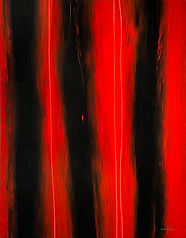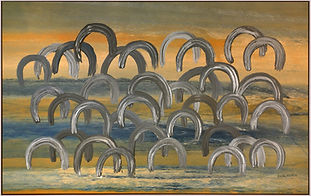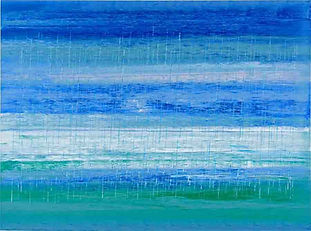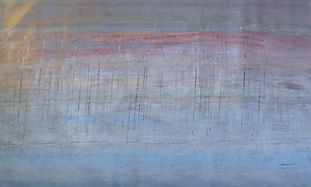PROFILE
Rosella Namok
1979
Rosella Namok describes herself as a ‘modern artist’. Her painting engages traditional themes but she explores them in her own distinctive style, bearing the markers of a modern sensibility. The ‘culture and stories’ of which Namok paints revolve loosely around several narratives. They are stories of her social and physical or natural environment featuring events such as hunting and fishing expeditions, weather patterns of rain and wind, or the stories of Kapay and Kuyan, the two opposing moieties that govern marriage relations in Namok’s Ungkum community. These tribal moieties were brought together into one community under the governance of the Christian missions that were established in the Lockhart River area in 1920. Also apparent in Namok’s work are themes relating to traditional knowledge of country including kinship relations as well as tribal law in relation to the both the individual and their community. In fact, it was her wish to explore and establish her correct lineage, her ‘right place’ within the whole, that initially sparked much of the imagery that takes shape throughout the entire scope of Namok’s art.
She emerged as a member of the Lockhart River ‘Art Gang’ that burst onto the contemporary art scene in the late 1990’s. Its formation following upon a successful program developed to encourage education and employment in an area that is quite remote from the larger cities of Queensland’s far north. The initiative brought the community together in its concern to provide vocational and enterprising opportunities for their young people. Well managed funds, regular art excursions and a succession of visiting artist’s (including Guy Warren, Garry Shead, Adam Rish and cartoonist Michael Leunig) propelled some members of the popular art classes into the league of professional practise, with Namok emerging as a leading figure. Printmaking, under the guidance of Fran and Geoff Barker, played a significant role in Namok’s artistic development, the consequences of which can still be seen in her layered approach to the use of colour. An element of the unexpected intrudes as different layers have subtle effects on each other, refining inherent oppositions.
A fundamental theme in Namok’s work is ‘Difference’, which she explores through deceptively simple motifs. The everyday titles of her paintings tether the abstracted imagery to the figurative ‘real world’, with all of its tensions and disharmonies. This is best illustrated in works like Main Street 2005, in which a series of concentric rectangles, optical and irregular, create a composition of shifting spaces, which generates an uneasy disconcerting atmosphere. Namok is painting the grid of her streets viewed from an aerial perspective, imitating a traditional Indigenous technique, (conventional in the acrylic dot paintings of the Western Desert). Her move into the abstract however, allows her to evoke the intrigues and disfunctionality within a largely closed community; the kind of stories we might witness if we were to x-ray the suburb from above. In this, and other similar works, Namok depicts the literal grid of streets and simultaneously evokes a grid of emotions and relationships thereby intuitively bridging the figurative/abstract, traditional/modern diametric. In such a way her symbols can represent both figurative and abstract forms without having to demarcate between the two. Her paintings resolve at the point of experience. They are expressions of a way of life in Lockhart River where ancestral heritage is part of everyday life, and tradition finds form in the modern.
Namok talks about the value of just ‘yarning’, telling stories as a way of communicating life experience (Neales 2002: 12). Yarning has the power to evoke Dreaming narratives or may be about the events of ongoing life that hold some meaning to Namok herself or her community. In a series of paintings concerning the ‘old girls’, Namok pulls strong lines across nebulous drifts of colour. Her technique mirrors the way the women draw their fingers through the sand while passing on stories. Like all of Namok paintings, this series resonates with her sense of pragmatism, reflected in the subjects she chooses to paint as well as in the vigour and inventiveness with which she conveys them to the canvass. Each panel is different, just as different characters emerge within the group of yarning women, but a tonal and formal coherence holds the series together. Namok’s ‘rain paintings’ have been the most commercially successful strand of her work. In these, shifting scapes of water and land reflect the volatile nature of the tropical weather. During the wet season, sheets of drenching rain and annual floods close the roads for up to five months. The mood and activities of the community significantly alter.
In her more recent works, Namok concentrates on a style of painting that involves building up layers of paint, wet on wet, over and over. Then, using a rubber thong or palette knife, she strips the layers back to reveal the shifting colours beneath. These works can be enigmatic or direct depending on serendipitous happenstance. It has been said that they evoke the feeling and effect of peering through a veiled window or doorway.
Since her first solo exhibition in 1999 at Sydney’s Hogarth Gallery, Namok has risen to prominence to become almost a celebrity figure; for at twenty-three she was, anecdotally at least, the highest grossing Australian artist of her age. Over the last decade she has exhibited around the world, She continues to work consistently from her home in Lockhart River, and from a studio in Cairns, where she now owns a home. Having smiled beatifically from the front cover of At Collector magazine and been included at such a tender age in its 50 Most Collectable artists, she has assumed a cult-like status with regular sell out shows at her galleries in Sydney, Melbourne and Brisbane.
ARTIST CV
MARKET ANALYSIS
Rosella Namok rose to sudden artistic prominence at 23 years of age. In 2001 and 2002 she was listed in Art Collectors 50 most collectable artists. She was cast, in the contemporary Indigenous art scene, as a celebrity figure and this, along with professional representation and sound mentoring, resulted in an exponential rise in the market value of her work. It is extraordinary to think that this young artist has already had at least 30 solo exhibitions since 1999 at galleries of the quality of Hogarth and Coo-ee Galleries in Sydney, Andrew Baker and Fireworks Galleries in Brisbane, Vivien Andreson and Niagara Galleries in Melbourne as well as October Gallery in London. In addition, her works have been shown in Paris, Washington, Georgia, Berlin, Austria and Slovenia. In 2000 she won the Lin Onus Youth Award at the fifth National Indigenous Heritage Art Awards and in 2004 the High Court Centenary Art Award. The list of quality galleries that have held her solo exhibitions is only just as impressive as the number of important Australian and International collections that have acquired her work.
Such was the hype around her persona and her art that Sydney Morning Herald art critic John McDonald, in commenting on the nature of buyers investing in her early work in 2005, noted that its entry into the market came at a time somewhat after the original boom period of investment in the contemporary Aboriginal art of Arnhem Land and the Western Desert. He described the collectors of Namok’s early work as heralding a ‘second wave’. of interest in Aboriginal art. He wrote: ‘I suspect that Namok’s work is being bought primarily as an investment, and only secondly by genuine fans. All those small buyers who never secured a Rover [Thomas] or an Emily [Kame Kngwarreye] when they were affordable are determined not to miss out this time around’ (McDonald, 2005, 28).
There is definitely a grain of truth in this. Her paintings first appeared on the secondary market in 2003 and at what is still a very early stage in her career, no less than 111 works have already been offered for sale in the secondary market. While the buoyant secondary market was dominated by private investors during the mid 2000s, there is, in equal part, a discernible league of genuine aesthetic appreciators to be found at her gallery openings, who continue to support her finest works, and paintings owned by these collectors are unlikely to appear at auction for quite some time.
Her two highest records at auction fit neatly with the prices currently asked by her primary market galleries for equivalent works. It would be a foolhardy secondary market player indeed that ignored such an important emerging primary market performer at such a vital stage in the development of their career. Her record stands at the $31,070 paid for a 165 x 260 cm canvas titled Rain Dreaming, which sold at Christie's in August 2005 (Lot 157), while her next best result was the $28,800 paid for the five panel Old Girls.They Talk in the Sand.Yarn Far Before Time 2004 in Lawson~Menzies June 2005 auction (Lot 59).
Namok is also known as a print artist however her works on paper have not fared well to date. Of the 10 prints offered only six have sold for a very disappointing $200 average price.
Only one work in her top ten results has resold and this occupies both her ninth and 11th best result. Para House 2001 a canvas measuring 186 x 133 cm, originally sold at Lawson~Menzies in May 2006 for $13,200 (Lot 38) and resold in Decmeber 2008 for $12,000 (Lawson Menzies Lot 216). It was a good work but demonstrated clearly the need to hold on to Namoks works for some time in order to take a profit. As if further evidence is needed, in 2007 and 2008 only 11 of the 25 offered have found a buyer. And results have been deeply disappointing at auction since that time.
Rosella Namock is a very interesting young Indigenous artist and collectors would be wise to keep a keep a cool but discerning eye on her progress over the coming years. Don’t be taken in by all the hype. She is a fine artist and is capable of beautiful enigmatic works that explore both the landscape of her country and the culture of its inhabitants. She has been positioned in the public eye as an example of a new wave of contemporary/traditional painters but her work defies simple categorisation. Her career was initially managed superbly and if, as we all hope, this continues, collectors should not be afraid to invest in her finest paintings. They will undoubtedly prove their worth both aesthetically and financially in the long term.
Disclaimer: At Cooee Art Leven, we strive to maintain accurate and respectful artist profiles. Despite our efforts, there may be occasional inaccuracies. We welcome any corrections or suggested amendments.
Please contact us with your feedback.



























